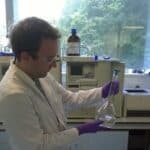-
Asked by deed1run to Martin on 15 Mar 2024.0
-
Martin Minarik answered on 15 Mar 2024:
Hi! Great question! Trial and error is one way to look at this for sure. We call it the ‘candidate gene approach’ and it means we would look at genes that we know are expressed in similar cell types for example, and check if they are active in hair cells, too. What may be a better idea though is to take what we call an ‘unbiased approach’, where you use some experimental technique to get a better idea about candidate genes without picking them yourself. We have done this by cutting out pieces of skin that contain hair cells, sequenced all the RNA in them, and then did the same with pieces of skin without hair cells. This gives you a list of genes present in the first sample that are not present in the second sample, and those are more likely to be active in the hair cells, ideally. RNA shows you which genes are switched on in the cells, so that’s why I look at RNA (DNA would be the same in all cells). There won’t be many genes that ‘code’ specifically for hair cells. Most of them are used in different parts of the body at different times to do completely different things. What’s important is the combination of the genes that are switched on and how they interact with each other that is specific for hair cells. Some of them may be switched off in humans and active in fishes or other animals, and who knows, maybe it’ll give us clues as to why humans cannot regenerate hair cells, which can lead to hearing loss and vertigo in old age!
-
Related Questions
what happens when a person whos sick gets a DNA while the person is sick what do you do
What is the most important type of cell in the immune system?
What genes do you take from your parents?
what is the nucleus made of
do you work on sex cells
Could you clone your self using your DNA? If so, how?
are there many women in your search
how big is a sperm cell
Someone (i Think zoe) mentioned that mitochondria where their own bacterial cell before they were taken in by another
how dos dna get damage
Latest Questions
-
How do you make new drugs
-
how many plants do you study normally?
-
what happens when a person whos sick gets a DNA while the person is sick what do you do
-
What are polysaccharides?
-
how many nuclear explosions happen in the world
-
how does your job effect your daily life ? (2 Comments)
-
why does nuclear waste glow in the dark? (1 Comment)
-
how to you deal with problems you come across when doing your research? (2 Comments)
-
If you have been emotionally invested (focusing on anxiety if you suffer with it, dementia etc) do you find it
-
what motivates you to carry out your research? (1 Comment)
Latest Comments
-
how does your job effect your daily life ? (2 comments)
-
why does nuclear waste glow in the dark? (1 comment)
-
what motivates you to carry out your research? (1 comment)
-
how to you deal with problems you come across when doing your research? (2 comments)
-
How long have you been a scientist for (2 comments)







Comments